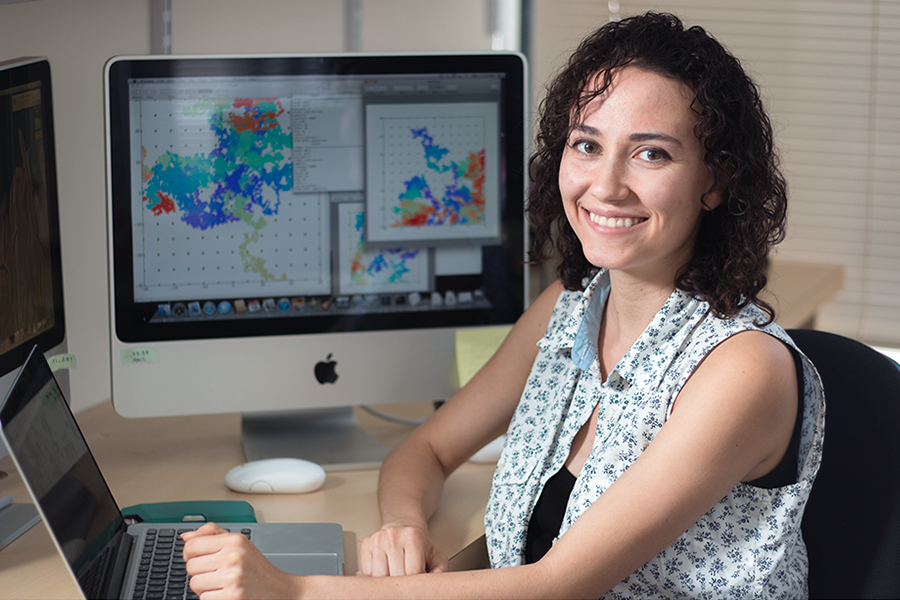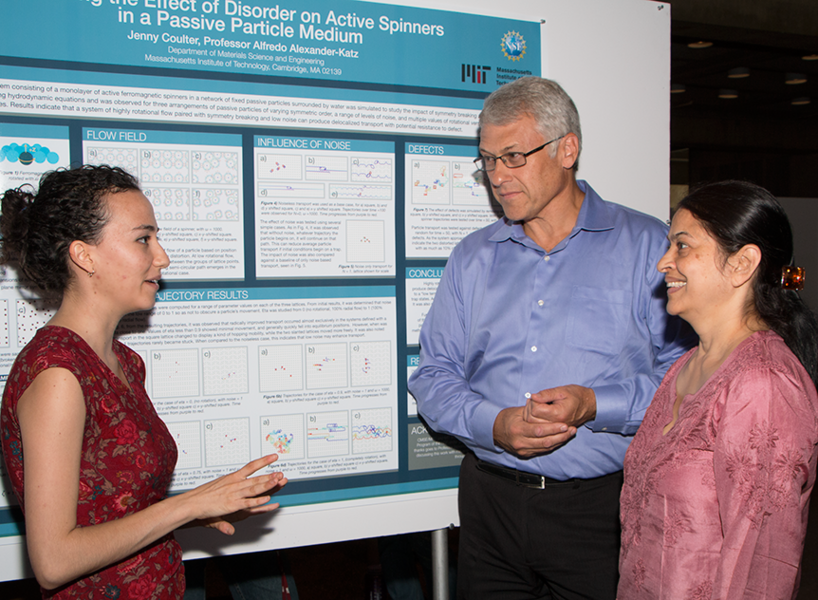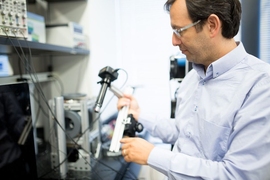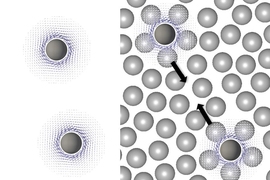Earlier this year, MIT Associate Professor Alfredo Alexander-Katz’s group demonstrated experimentally that ferromagnetic particles spinning under a rotating magnetic field in a milky suspension are attracted to each other across relatively long distances in a crowd of non-magnetic particles.
This summer, Materials Processing Center (MPC)-Center for Materials Science and Engineering (CMSE) Summer Scholar Jennifer Coulter interned with Alexander-Katz, the Walter Henry Gale Associate Professor of Materials Science and Engineering at MIT on a project to develop a more generalized computer model for these active spinning particles in a passive colloidal mixture. “We’re studying the interactions of the spinners with the passive particles through simulation,” Coulter says. Describing this theoretical environment, Coulter explains, “Only the spinners move.” The non-magnetic particles are in fixed a pattern without moving during the simulation.
The power of soft
This project fits into the Alexander-Katz lab’s work on a wide range of active soft-matter challenges from understanding how neurotransmitters move from one neuron to another in the brain to how single-celled organisms sense each other at a distance. “The power of soft means [that] with very small stimuli we can actually have large or strong changes,” said Alexander-Katz, a member of the Physics of Living Systems group, during a presentation to Summer Scholars in June.
For Coulter, a rising senior at Rutgers University whose prior work focuses on high-energy physics, biophysics is new territory. “The way I’ve been working with him on this project has been an experience in using what I know in terms of computing and general physics knowledge to develop and explore a new system,” she says.
“I’ve actually found that a lot of the work I did in high-energy physics has been really useful because that’s also computational, even though it’s very different. So I had some skills coming in, but I’ve definitely had some time to work on them here,” Coulter says.
“I’m running larger-scale things, where I have to deal with huge numbers and lots of data, so I need to consider things in Unix command lines,” she says. “I’m using different computers to run my code, because I can’t run it on my laptop. It would overheat or take days,” Coulter explains. She is writing much of the code for this project herself from scratch using Python and a mix of Unix tools including Bash and Shell scripts.
Graduate level skills
“I think that in terms of just general computing stuff, in Unix and other things, it’s been really good to spend more time working on that, because those are skills I hope to use in grad school. I’d like to go for computational physics, probably,” Coulter says.
Using this computer model, Coulter analyzed how changes in simulation specifications affect the end result. For example, she could alter the speed at which the magnetic field rotates, change the torque from hydrodynamic interactions and modify the attractive or repulsive force between spinners and passive particles.
“The key thing that we’re going to vary is a parameter that’s going to help us describe the disorder of the way we’ve arranged the passive particles; so we want to study how disorder affects the transport of the spinners through the passive particles,” Coulter says. The simulations cover a range from a highly ordered system through a range of different distortions to the ordered system to see how spinners behave as disorder increases.
She hopes to learn under what conditions spinners move in a straight line versus a diffuse pattern — that is, scattered in different directions. “I think it would be cool if we could see really diffusive transport in relation to adding disorder to our system,” Coulter says. “The end goal is to compare the active matter system to a system that’s currently very popular in terms of topological materials and 2-D materials and transport in those materials. So we would like to try to create this system as an analogue to that more difficult to study system.”
Coulter says Alexander-Katz has been an extremely involved advisor. “I think in terms of my personal growth, actually the best part of my experience here has been just working with Prof. Alexander-Katz,” she says. “It’s really nice to be able to talk to him for an hour or more at a time, several times a week. He’s really supported me and gives really good feedback, and I think in terms of my development as a scientist, a lot of what I’ve gained from this has just been in my experience working with him. I really appreciate his role as a mentor.”
Success for her project would be characterizing the disorder of the arrangement of passive particles, and how it changes the nature of transport for the spinners, Coulter suggests. “It’s actually, I think, something we’re pretty close to attaining, but since it was a smaller project, we are now starting to do some more final runs of the code. I’m about to get some of the last results soon ... so hopefully they’re the good kind. They’ve looked really promising up to this point.”
MPC and CMSE sponsor the nine-week National Science Foundation (NSF) Research Experience for Undergraduates internships with support from NSF’s Materials Research Science and Engineering Centers program. The program ran from June 7 through Aug. 6.









